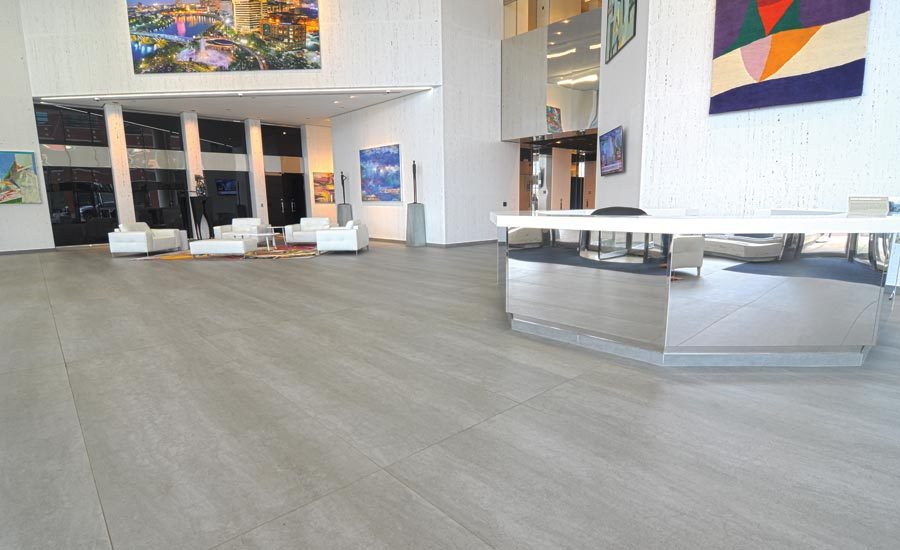Gauged porcelain tile panels have enjoyed robust growth for the past five years commercially, and interest is steadily gaining momentum in the residential market. The panels appeal to architects and designers because of their modern look, and industry leaders are actively strategizing manufacturing, training and outreach to ensure there is a steady pipeline of product and qualified installers to fulfill market demand.
“We are up 50% from last year as far as large-format-panel sales,” said Eugenio Megna, director of sales and marketing, Transceramica, internal distributor to Italian tile manufacturer Fiandre, and subsidiary to Iris Ceramica.
U.S.-based Crossville Tile has seen 40% sales growth in the category every year for the last five years, according to Noah Chitty, director of technical services. For next year, the company anticipates growth should be around 15 to 20%.
“This product category is still growing exponentially,” Chitty said.
Stonepeak Ceramics, another subsidiary of the Italian holding group Iris Ceramica, launched its first production line in the United States dedicated to 120x60 large-format panels in September. The plant is the first to produce large-format porcelain panels that range from 6 mm to 2 cm thick in the United States, according to Doug Snell, vice president sales and marketing.
“This will allow us to offer more stocked products, faster delivery and the benefit of not having a 10% duty that is added to imported containers,” Snell said. “Distributors can use our inventory instead of having to buy a container, which in the past could have taken 10 to 12 weeks for delivery. By producing in the States, we are also in control of our colors.”
Eighty-five percent of Fiandre’s business in gauged porcelain panels is to the commercial market, however, Megna contends that porcelain panels can and should be successfully sold to higher-end residential projects.
“You cannot compare the installation of 12x24 glazed porcelain to that of porcelain panels—it’s not a fair comparison,” Megna said. He suggests that the fairer comparison is to do a cost-benefit analysis with natural stone.
“For a similar budget as natural stone, porcelain panels offer the look with so many benefits. A homeowner gains a full shower surround with no grout, countertops and floors—and you do not have the maintenance. There are markets like the North Shore of Chicago or Beverly Hills that still want natural stone for the status, but for many it is a light bulb going off.”
While the residential contractor market is still a little bit hesitant overall, Megna said he is seeing ambitious contractors embrace the technology on the East Coast, the West Coast and in Texas.
“I feel like we are over the hurdle that if we get the product sold we can’t find anyone to put it in, but the product category is still growing exponentially, and we need to be prepared,” Chitty said.
To date, Crossville has trained 1,700 tile contractors and more are needed to keep up with demand.
“The category has some infrastructure now,” Chitty said. “We have an interior installation standard, a product standard, and we anticipate training another 200 to 400 installers next year.”
Since Crossville’s sales are primarily commercially driven, the majority of the contractors the company has trained are commercial, Chitty said.
“We are seeing more demand in the residential segment, which wasn’t there two years ago, so now we are losing the small jobs that we can’t find anyone to put in because they are too busy or doing commercial work,” he noted.
To solve the problem, Crossville is teaming up with setting material manufacturers and the National Tile Contractors Association to do more regional training for contractors in 2019, which will allow them to increase the number of installers trained for residential projects and place more company resources towards outreach to architects and designers.
“Currently, it’s at least a day and a half of travel for contractors to get to Crossville for training,” Chitty said. “If we can reach contractors locally, it will save them time, but it’s also about keeping up the quality of the training.”
To see more of the latest trends in tile & stone, click here!
This could be a boon for smaller tile shops who have the bandwidth to grow their businesses. In addition to the time spent training, residential tile contractors should anticipate investing $2,500 to $3,000 on specialized handling equipment for moving the panels into place and tools that are designed for cutting the larger panels.












